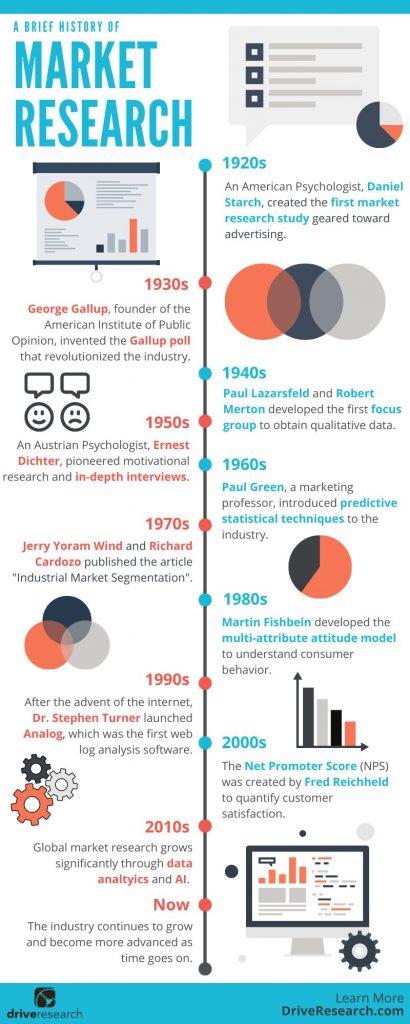
In the past 100 years, the market research industry has evolved significantly into an incredibly beneficial tool for companies to use to enhance their business and marketing plan.
Market research is commonly used to:
- Form strategies
- Inform decision-making
- Gain a deeper understanding of target audiences
- Help businesses connect with consumers
- Strengthen brand reputation
In order to reap the benefits of market research, one must understand the origins of research methodologies and practices that we depend on today.
This timeline shows the evolutionary process of how far market research has come in the last century.

The 1920s-1940s: Advent of Quantitative Market Research
Daniel Starch
In the 1920s, Daniel Starch, an American psychologist, pioneered the first market research study with the goal of making advertisements more enticing to consumers.
How did he develop it, you might ask? Through in-depth interviews!
Starch and his research team gathered a random sample of respondents by going door-to-door to ask them a series of questions relating to advertisements in magazines.
After the interview process was complete, Starch and his staff would analyze the data and compare results to see which advertisements were most effective and memorable to the consumers.
Following the success of the first-ever market research study, companies adopted Starch’s methodologies to improve their marketing strategies.
George Gallup
After Daniel Starch, there was George Gallup, who furthered the development of Starch’s study with his theory of aided recall, which is a question-asking strategy that examines the memorability of an ad.
Gallup’s strategy asked questions regarding advertisements in magazines without showing the advertisements to the respondents. This technique would later be adapted and used to gauge the effectiveness of commercials.
Fun fact: In 1936, Gallup and his team accurately predicted that Franklin Roosevelt would win the U.S. presidential election. His prediction secured the public’s trust in polling data and survey research.
The 1940s-1960s: Introducing Qualitative Market Research
After World War II, consumerism helped invigorate the economy, which emerged the need to better understand the consumer on a personal level and gain insight into their decision-making process.
To learn more about consumers, market researchers developed and conducted qualitative surveys, such as usage studies and attitudinal research, to understand a customer’s motivation, attitudes, and feelings toward a product or service.
A common method to understand consumers was to use focus groups.
However, researchers questioned the effectiveness of the process due to the inconsistencies between the participants’ thoughts and actions.
Ernest Dichter
In order to improve this process, Ernest Dichter, an American psychologist, introduced a new iteration of consumer research in the 1950s, known as Motivational Research.
This evolution of market research was based on Freudian psychology.
Therefore, Ditcher believed each consumer had subconscious desires, taboos, and repressions, prompting ethnography studies and in-depth interviews with consumers.
Learn more about market research best practices borrowed from psychology.
The 1960s-2010s: Refining Market Research
In the 1960s, the development of qualitative and quantitative research began to accelerate with the presence of new technological advancements in the market research industry.
Paul Green
A marketing professor by the name of Paul Green used the power of statistics to make accurate predictions about consumer behavior.
An article in a mathematical psychology journal inspired Green’s work and reoriented his approach to measuring data and applying it to marketing.
Fun fact: Paul Green was awarded the Lifetime Achievement Award from the American Marketing Association in advancing the market research industry with his statistical techniques.
John Howard
As for qualitative research, John Howard, a marketing expert and author, began to add social sciences elements to his practice.
Howard’s multi-disciplinary approach to further understand consumers included:
- Sociology
- Anthropology
- Psychology
- Semiotics
Martin Fishbein
Later, researchers, like Martin Fishbein, incorporated the role of emotions, motivations, feelings, behaviors, and moods to understand customers.
His multi-attribute attitude model is still used to this day.
The 1990s
In the 1990s, the market research industry continued to evolve with the invention of the world wide web.
More specifically, the first website was available in 1991. This invention revolutionized how individuals acquired information.
By 1995, Analog was introduced to the world as the first web analysis software, which paved the way for analytical systems such as Google Analytics.
Fun fact: Popular e-commerce corporations such as Amazon, Craigslist, and eBay were created during the time of Analog’s launch.
Present: Modern-Day Market Research
Market research has currently evolved with a multitude of tools, methodologies, and techniques at its disposal.
As noted above, this is derived from years of exploration, experimentation, innovations, and hard work.
Many methodologies have moved online. For example, organizations are steering away from hosting traditional focus groups and using remote focus groups instead.
Today, market research is no longer a lengthy or costly process, which means anyone can reap the benefits of modern-day market research. Our market research company believes it’s just going to get better from here.
Contact Our Full-Service Market Research Company
Drive Research is a full-service market research company. Our experts stay up-to-date with current industry trends to deliver the most cost-effective and efficient research approaches. To learn more about our services, contact us today.



